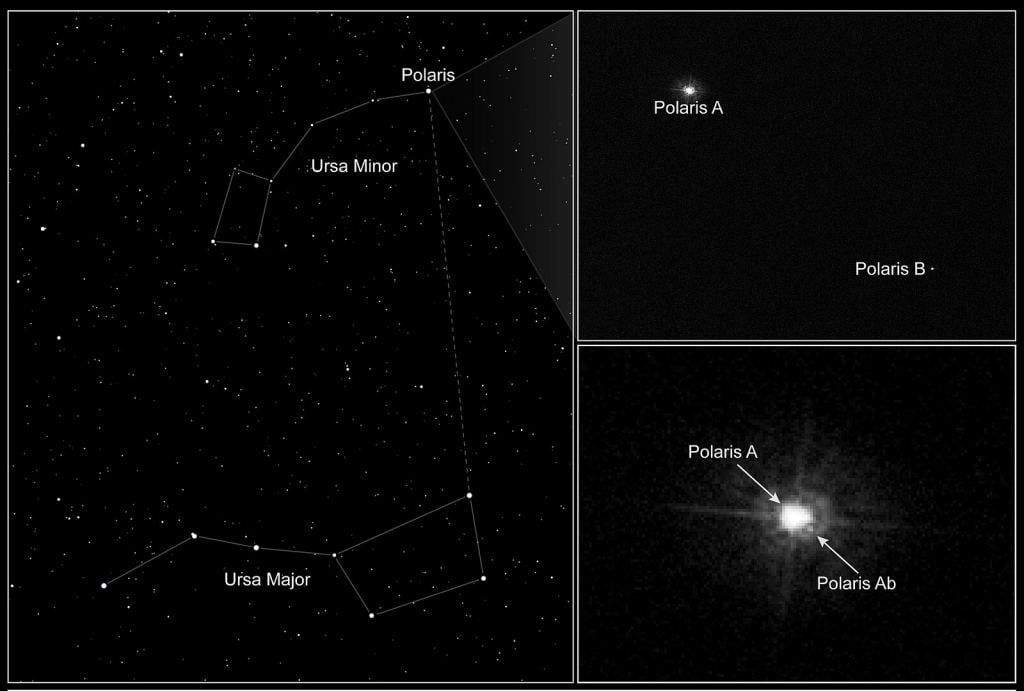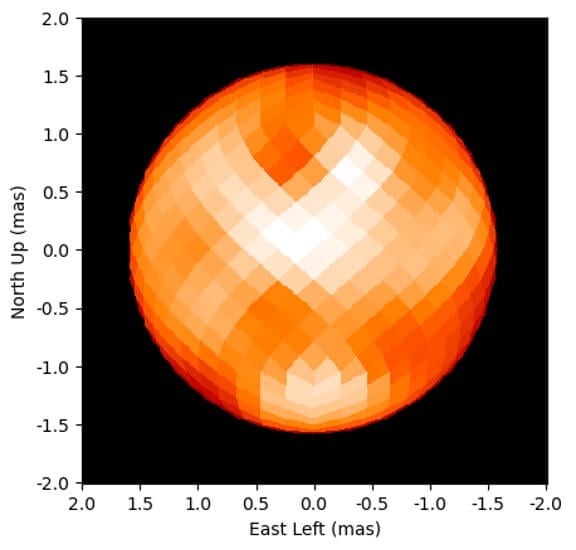Humanity's been fortunate to have a star situated over Earth's north pole. The star, known as Polaris, or the North Star, has guided many sailors safely to port. But Polaris is a fascinating star in its own right, not just because of its serendipitous position.
Polaris is also called the Pole Star, and it's actually a triple star system. The primary star is a yellow supergiant named Polaris Aa, about 448 light-years away, and it orbits with a smaller companion named Polaris Ab. The outer star is named Polaris B and may also have a dim companion. In this article, Polaris refers to the primary star, Polaris Aa.
Polaris hasn't always been the North Star, and it won't always be. Thuban was the North Star from the 4th to 2nd millennium BC until Earth's axial precession gave that position to Polaris. The Pole Star changes during a 26,000-year cycle, so Thuban will take over from Polaris in the year 20346.
But whether Polaris is the Pole Star at a particular time or not, it's an interesting object whose properties can help us understand the expansion of the Universe.
Polaris is a variable star that pulses and changes brightness over time. Specifically, it's a Cepheid variable. Cepheid variables expand and contract rhythmically, and their brightness changes in a predictable pattern. Because there's a direct relationship between their pulsation period and their luminosity, they're useful in measuring distances. They're called "standard candles" and are part of the cosmic distance ladder.
Astronomers use standard candles to help measure the Hubble constant, or how rapidly the Universe is expanding. But there's some tension between our measurements of the Hubble constant. When we use local objects like Cepheid variables to measure the Hubble constant, we get a different number than when we use larger-scale things like the [Cosmic Microwave Background](https://www.esa.int/Science_Exploration/Space_Science/Cosmic_Microwave_Background_CMB_radiation#:~:text=The%20Cosmic%20Microwave%20Background%20(CMB,soon%20after%20the%20Big%20Bang.) to measure it.
Since Polaris is such a nearby standard candle, a team of astronomers used a telescope array to watch the star for 30 years. By more accurately observing Polaris and its smaller companion Polaris Ab, they hoped to constrain Polaris' mass and other characteristics more accurately. This, in turn, could help us understand the tension in the Hubble constant. Along the way, the researchers uncovered some surprises surrounding this long-observed star.
Their results are in a paper titled " The Orbit and Dynamical Mass of Polaris: Observations with the CHARA Array. " It's published in The Astrophysical Journal, and the lead author is Nancy Evans. Evans is an astrophysicist at the Center for Astrophysics | Harvard & Smithsonian.
In order to understand Polaris better, it's critical to get a good look at its dim companion. But that's not easy to do.
"The small separation and large contrast in brightness between the two stars makes it extremely challenging to resolve the binary system during their closest approach," Evans said.
The CHARA (Center for High Angular Resolution Astronomy) Array was built to bring clarity to objects like Polaris and its dim companion. It's an interferometer, an array of six separate telescopes, each with a one-meter-diameter primary mirror. By combining the images from each separate scope, CHARA attains the higher resolution of a telescope with a primary mirror that's 330 meters in diameter, the area covered by the individual 'scopes. CHARA has a special camera designed to work with it called MIRC-X (Michigan InfraRed Combiner-eXeter).
With these tools, the astronomers tracked Polaris and its dim companion over a 30-year period. They measured how the Cepheid variable changed size as it pulsated. They learned that it's five times as massive as the Sun and has a diameter 46 times larger than the Sun. However, the mass measurement is affected by the star's large orbital eccentricity, 0.63, so there's still some uncertainty about Polaris' mass.
The measured mass and luminosity also show that Polaris is more luminous than it should be for a star on its evolutionary track. "Polaris is at least 0.4 mag brighter than the predicted tracks," the authors write in their paper. This is important because of the " Cepheid mass problem." It's a discrepancy between masses inferred from stellar evolutionary tracks and masses from pulsation calculations.
A Cepheid variable's mass can be determined when it's in a binary relationship. "Mass determination starts with a radial velocity (RV) orbit and pulsation curve for a binary containing a Cepheid," the authors explain. Very few Cepheid variables are in binary relationships like Polaris, so it's an important target for constraining and understanding their masses. These measurements are all important because they relate back to the cosmic distance ladder, standard candles, and the Hubble constant.
"The accuracy of inputs from any of these measurements depends on many characteristics of the star: brightness, orbital period, inclination, and the separation, distance, and mass ratio of the components. This means that each Cepheid system is unique and has to be analyzed independently," the authors explain.
The observations also showed variable spots on the star's surface.
"The CHARA images revealed large bright and dark spots on the surface of Polaris that changed over time," said Gail Schaefer, director of the CHARA Array.
"The identification of starspots is consistent with several properties of Polaris," the researchers write. It's different from other Cepheid variables because it has a very low pulsation amplitude. That could mean that its atmosphere is more like a nonvariable supergiant. Those atmospheres often seem to be active, much like the spots on Polaris. "It is not clear how full amplitude pulsation affects the atmosphere and magnetic field in pulsators, so Polaris is an interesting test case," they explain.
The spots are variable, which could explain why astronomers have struggled to identify other "additional periodicities" in the star. They could also explain an observed ~120-day radial velocity variation as a rotation period.
The spots on Polaris' surface have added to the star's complexity, and they're begging to be understood.
"We plan to continue imaging Polaris in the future," said study co-author John Monnier, an astronomy professor at the University of Michigan. "We hope to better understand the mechanism that generates the spots on the surface of Polaris."
 Universe Today
Universe Today


